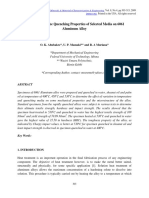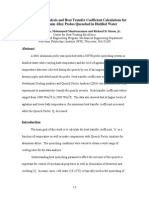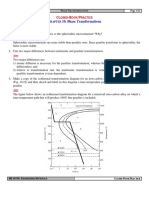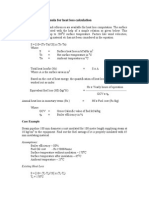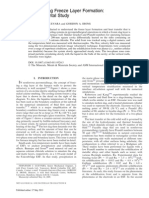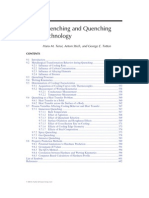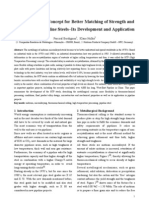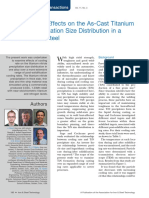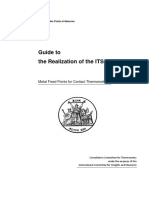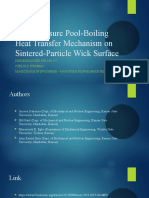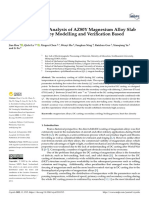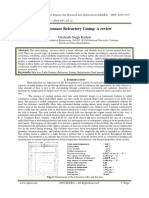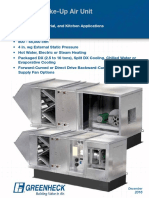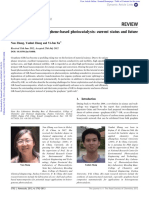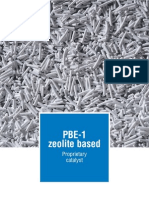Advances in Polymer Quenching Technology PDF
Advances in Polymer Quenching Technology PDF
Uploaded by
dalzochio100 ratings0% found this document useful (0 votes)
241 views8 pagesIn this paper, three technologies utilizing polymer quenchants will be reviewed. These include: inverse hardening, intensive quenching and ITQT, a computer automated time quenching technology. Aqueous solutions of water-soluble polymers such as poly(alkylene glycol) have been shown to provide more uniform heat removal during quenching.
Original Description:
Original Title
Advances in Polymer Quenching Technology.pdf
Copyright
© © All Rights Reserved
Available Formats
PDF, TXT or read online from Scribd
Share this document
Did you find this document useful?
Is this content inappropriate?
Report this DocumentIn this paper, three technologies utilizing polymer quenchants will be reviewed. These include: inverse hardening, intensive quenching and ITQT, a computer automated time quenching technology. Aqueous solutions of water-soluble polymers such as poly(alkylene glycol) have been shown to provide more uniform heat removal during quenching.
Copyright:
© All Rights Reserved
Available Formats
Download as PDF, TXT or read online from Scribd
Download as pdf or txt
0 ratings0% found this document useful (0 votes)
241 views8 pagesAdvances in Polymer Quenching Technology PDF
Advances in Polymer Quenching Technology PDF
Uploaded by
dalzochio10In this paper, three technologies utilizing polymer quenchants will be reviewed. These include: inverse hardening, intensive quenching and ITQT, a computer automated time quenching technology. Aqueous solutions of water-soluble polymers such as poly(alkylene glycol) have been shown to provide more uniform heat removal during quenching.
Copyright:
© All Rights Reserved
Available Formats
Download as PDF, TXT or read online from Scribd
Download as pdf or txt
You are on page 1of 8
1
ADVANCES IN POLYMER QUENCHING TECHNOLOGY
G.E. Totten
1
, B. Liscic
2
, N.I. Kobasko
3
, S.W. Han
4
and Y.H. Sun
1
1. Union Carbide Corporation, Tarrytown, NY
2. University of Zagreb, Zagreb, Croatia
3. National Thermophysics Institute, National Academy of Sciences, Kiev, Ukraine
4. Kum Won Industrial Company Ltd., Chungnam, Korea
ABSTRACT
Polymer quenchants are being used increasingly in the
heat treating industry. One reason for this increase is the
continual engineering advancements that facilitate their
replacement of quench oils and also water. In this paper,
three technologies utilizing polymer quenchants will be
reviewed. These include: inverse hardening, intensive
quenching and immersion time quenching technology
(ITQT), a computer automated time quenching
technology.
INTRODUCTION
With the exception of water, oil quenchants have
traditionally been the most commonly used quenching
media in the heat treating industry, particularly for crack-
sensitive steels such as bearing and tool steels.[1]
However, with increasing environmental, disposal, safety
and toxicological concerns, there is an increasing interest
in the potential use of alternative quenching technologies.
One of the most commonly considered alternatives to
quench oils are aqueous solutions of water-soluble
polymers such as poly(alkylene glycol). In addition to
providing substantially greater safety with respect to fire
and disposal, polymer quenchants have been shown to
provide more uniform heat removal during quenching
resulting in reduced thermal gradients and reduced
distortion.[1,2]
In this paper, three applications of recent polymer
quenching technology research will be discussed: 1.)
inverse hardening, 2.) intensive quenching and 3.)
immersion time quenching technology (ITQT). Each
discussion will include a brief introduction, description of
the technology and an application example.
DISCUSSION
A. Inverse Hardening Technology
Shimizu and Tamura were the first to report on the inverse
hardening phenomenon where the hardness at the core of
a round bar was greater than the surface.[3] Inverse
hardening was reported to be dependent on steel
hardenability, cross-section size and the on quenching
conditions.
Loria showed that contrary to expectations from Jominy
hardenability data and CCT diagrams, low-alloy steel
plates of 25.4-31.8 mm thickness can be quenched after as
much as a 120 second delay and still produce the same or
higher hardness than by direct quenching.[4] This was
reported to be due to the incubation process reflected by
the displacement of the transformation start curves in a
CCT diagram when using air cooling times in the A
3
to A
1
temperature range prior to water quenching.[4]
At the same time Shimizu and Tamura provided a
theoretical explanation for inverse hardening. Distribution
after quenching. [5] They also found that the pearlitic
transformation behavior with cooling rates
discontinuously changed during continuous cooling was
different than that predicted from the usual CCT diagram.
This transformation was related to the incubation time
consumed before changing the cooling rate.
In the case of delayed quenching, some of the incubation
time is consumed at the surface, while not at the center.
The incubation period at any given temperature is the time
until transformation starts (Z), while (X) is the incubation
period consumed before the discontinuous change of the
cooling rate has taken place. Figure 1A, which is the
schematic illustration of delayed quenching, shows that at
time (t
1
) and temperature T
1
(at point P) , a discontinuous
change of cooling rate occurred. Up to this moment, the
surface of the specimen has consumed a portion (X) of the
2
total incubation time (Z), but the center has not because
the at the moment t
1
, the center had a temperature above
A
1
. Further cooling below the point (P) has proceeded
with substantially increased cooling rate. Starting for the
center from temperature A
1
at zero time, further cooling
below the point (P) has proceeded with substantially
increased cooling rate changing the transformation start
curve as shown in Figure 1B. In this way, the cooling
curve for the center which does not intersect any pearlitic
region, results in higher hardness than the cooling curve
for the surface which has started from point (P) and
intersected a portion of the pearlitic region.
Figure 1 Schematic illustration showing how delayed
quenching results in inverse hardening.
Every delayed quenching process is accompanied by a
discontinuous change in heat transfer at the surface of the
quenched part and thus a discontinuous change in cooling
rate in the subsurface region. Relatively high
concentrations of aqueous poly(alkylene glycol) - PAG -
polymer solutions provide a predetermined and
controllable delay in quenching by variation of the
polymer concentration.[6] To understand the possibility of
a controllable delay upon immersion in an aqueous PAG
quenchant, it is necessary to understand the heat transfer
mechanism.
When austenitized steel is first immersed in an aqueous
polymer solution, it is surrounded by a vapor film which
is encapsulated by a mobil hydrated polymer film as
shown in Figure 2. [1] Cooling is very slow in this region
(film boiling). When the thermal energy is sufficient to
rupture the film, heat transfer will be facilitated by a
nucleate boiling process. This is the point where
discontinuous heat transfer may occur. One of the most
critical regions with respect to facilitating inverse
hardening is the initial film boiling region. The film
boiling process is controlled by the thickness of the film
(polymer concentration), agitation rate, bath temperature
and the film strength of the polymer (molecular weight
and polymer type). To date, only one aqueous PAG
polymer quenchant has been observed to provide
controllable delayed quenching behavior. [6]
Figure 2 - Illustration of the quenching mechanism of an
aqueous PAG quenchant solution.
Controllable delayed quenching (CDQ) means that there
is a predetermined change in heat transfer on the cooling
surface during quenching which influences the dynamics
of heat extraction. The heat extraction rate at the surface
of a cooling specimen and any point through the radius to
the core can be determined using the Liscic-Nanmac
probe and the Temperature Gradient Method. [1,7,8]
The time where the maximum heat flux density occurs
(t
qmax
) is the real measure of delayed quenching. Figure
3A shows the temperature-time profile when quenching
the Liscic-Nanmac probe in mineral oil at 20
O
C and no
agitation. Figure 3B shows the calculated heat flux
between 1.5 mm below the surface and the surface itself
versus time. In this case, the heat flux maximum occurred
3
at 12 seconds after immersion and there is no indication of
a discontinuous change in cooling rate.
Figure 4 illustrates the temperature-time profile for the
same probe quenched in a 25% aqueous solution of a
PAG quenchant [6]. In this case, the maximum heat flux
density occurred at 70 seconds after immersion and a
discontinuous heat transfer condition was observed.
Figure 3 - A. Cooling curve for the Liscic-Nanmac probe
(50 mm Dia x 200 mm cylinder); B. Heat flux density
between T
t
and T
S
versus time when quenching in mineral
oil at 20
O
C, no agitation.
Figure 5 illustrates the normal hardness distribution
measured across the section of a 50 mm round bar of AISI
4140 quenched in the mineral oil (Figure 3) and the
aqueous PAG polymer quenchant (Figure 4). This figure
clearly illustrates the inverse hardening effect attainable
with the PAG quenchant.
Recently, a study was conducted to evaluate the potential
effect of inverse hardening on the fatigue strength of AISI
4140. The results obtained, see Figure 6, showed that after
quenching and tempering, an increase in bending fatigue
life factor of approximately 7 and an impact energy
increase of approximately 7% relative to mineral oil
quenched specimens with a normal hardness distribution.
Figure 4 - A. Cooling curves measured by the Liscic-
Nanmac probe (50 mm Dia x 200 mm); B. Heat flux
density between T
t
and T
S
versus time when quenching in
an aqueous PAG quenchant at 25%, 40
O
C and 0.8 m/s.
Figure 5 - Normal hardness distribution (1) after
quenching in mineral oil with no agitation at 20
O
C;
Inverse hardness distribution after quenching in an
aqueous PAG polymer solution at 25%, 40
O
C and 0.8 m/s
agitation.
4
Figure 6 - Test results of quenched and tempered AISI 4140 test specimens prepared with normal and inverse
hardness distribution.
B. Intensive Quenching
Intensive quenching refers to quenching processes
utilizing very strong agitation, typically involving high-
pressure sprays. Intensive quenching is usually typified
by Grossmann quench severity factors (H) 5.0 as
shown in Table 1. [10,11]
Table 1
Classification of the Severity
of Different Quenchant Media
Cooling Rate
Classification
Quenchant Type and
Agitation
Quench
Severity (H)
Slow Cooling
Oil - None
Oil - Violent
0.2
0.7
Fast Cooling
Brine - None
Brine - None
2.0
5.0
Intensive
Cooling
Brine or Aq. Polymer-
High Pressure Spray
5
One of the oldest known examples of intensive
quenching was the production of the rear axles for the
Ford Model T automobile using AISI 1035
modified.[10] Today automotive axles, punches, and
other parts produced from shallow-hardening steel
continue to utilize intensive quenching (shell
hardening) processes. [10,12]
Intensive quenching produces high residual compressive
stresses in the surface of the part. [12,13] The reasons
for using intensive quenching processes include:[10]
1. To achieve maximum martensitic microstrucures in
the surface of a part.
2. To develop maximum surface compressive residual
stresses. [12,13]
3. To achieve optimal quench uniformity.
4. To achieve maximum depth of hardening with a
given alloy content to reduce production costs and
to take advantage of available steels.
5. To insure maximum hardening in critical areas of
parts such as in the root fillets of a gear.
6. To minimize heat treating distortion and maximize
uniformity.
7. To obtain optimal physical properties such as
tortional fatigue. [10]
5
Although intensive quenching processes are known, this
is not a widely applied technology. However, because of
the cost savings offered and potential improvement in
the steel properties using low alloy and carbon steels,
this technology is being used increasingly in the
countries of the Former Soviet Union (FSU). For
example in one bearing plant, the lifetime of dies like
those illustrated in Figure 7 which were constructed from
IIIX-15 steel (0.9501.10 C, 0.2-0.4 Mn, 0.15-0.35 Si,
1.30-1.65 Cr) was evaluated. Tests showed that
intensive quenching provided 1.5-2 times longer
lifetimes than obtained with an oil quenching process.
Figure 7 - Illustration of a die that was intensively
quenched.
The most severe operating conditions and most
expensive processing conditions are encountered when
thermal processing high alloy tool steels. Typically, parts
produced from these steels are heated in salt pots and
quenched in brine or alkali. Any simplification of this
process is of great practical interest.
In 1990, Bulgaria liscensed an intensive quenching
process and began commercially producing punches and
pelt strippers. The shape and sizes of these parts is
illustrated in Figure 8. The use of the intensive cooling
process increased the lifetime of the tools by 1.5 - 2
times. [15]
Figure 8 - Illustration of punches manufactured using an
intensive quenching process.
Analogous results were obtained with dies used for
growing artificial diamonds (see Figure 9). In both cases,
aqueous solutions of calcium chlorise and magnesium
chloride containing corrosion inhibitors were used as the
quench media.
Figure 9 - Illustration of a die used for growing artificial
diamonds.
Despite positive results, intensive quenching conducted
with a bischofite (chloride) solution has not been readily
accepted because of the associated corrosion problems.
However, it is now possible to obtain the same result
with aqueous PAG polymer quenchants with the
corrosion problems that accompany the use of chloride.
6
For quenching high-speed steel, aqueous solutions of
PAG were used with intensive quenching. Tool life
increased significantly.[15] This shows that it is possible
to to combine intensive steel quenching methods and use
PAG quenchants.
Intensive quenching technologies in use in Ukraine and
Bulgaria, and Russia are described in Reference 16. The
use of aqueous chloride solutions as quenchants for
intensive quenching are described in Reference 17. The
use of PAG quenchants for intensive quenching is
currently being studied in more detail.
C. Immersion Time Quenching Technology - ITQT
When polymer quenchants are used with crack-sensitive
steels, it may be necessary to minimize cooling in the
martensitic transformation (Ms) region to minimize both
transformational and thermal stresses during quenching.
For polymer quenchants, this may be accomplished by
increasing the polymer quenchant concentration and/or
increasing the bath temperature. Alternatively, quench
severity can be reduced by decreasing the agitation rate.
Of these variables, only agitation rate can be controlled
during the time cycle of the quenching process.
Although time quenching is a well known and traditional
heat treating process, the ability to continuopusly control
agitation during the quenching process is a more recent
development.[18] Recently, commercial examples of
continuous agitation control using a computerized
Immersion Time Quenching System - ITQS. Many
ITQS system variations , both batch and continuous, are
being used in Korea at the present time.[18,19,20] Two
examples will be provided here.
The first example to be discussed is the batch production
of roller bearings. A PAG quenchant (8% UCON
Quenchant A) has been successfully used to replace a
brine quench for the production of carburized (AISI P2)
roller bearings with the following dimensions: 44 mm
OD, 35 mm ID and 35 mm long. Each bearing weighed
454 grams. The total load size was 130 kg, including the
weight of the fixture. The batch ITQS tank contained a
total of 4700 liters of quenchant which was agitated
using a single draft-tube which encased a 540 mm
impeller mixer driven by a 10 Hp motor.
Traditionally, the bearings were pack-carburized in a
compound of charcoal and barium carbonate at 950-
980
O
C for 24 hours in a pit furnace. The case depth was
2.5 mm. The load was reheated in a 5-10% sodium
cyanide salt bath at 830
O
C for 25 minutes at which time
they were brine quenched at ambient temperature.
For the batch ITQS procedure, the same carburizing
process was used. However, the reheating process was
conducted at 900
O
C for 60 minutes in a neutral
benzene/methanol (20/1.5 liters respectively)
atmosphere. The load was then quenched in 8% UCON
Quenchant A at 27-30
O
C for 10 seconds at 1.2 m/s
followed by a slower quenching step by reducing the
agitation rate to 0.2 m/s.
A comparison of the metallurgical results for quenching
processes is provided in Table 2.[19] The results show
that the ITQS polymer quench system will: provide a
substantial reduction in bearing distortion, reduce
grinding depth, eliminate the sodium cyanide effluent
problem and reduce heat treating cost including total
energy, processing chemicals and water contamination.
Table 2
Comparison of Brine and Batch ITQS Polymer
Quench Processes for Roller Bearing
Result
Brine
Quench
Batch ITQS
Polymer Quench
Hardness (Rc) >60 >60
Case Depth (mm) 2.5 2.5
Distortion (mm) 0.25 0.067
Grinding Depth (mm) 0.5 0.2
Track links (AISI 15B37) such as those illustrated in
Figure 10 were prepared from a direct forge condition
using a continuous ITQS process. In this case the aquous
PAG quenchant that was used was UCON Quenchant
E. at 10-12%. The bath temperature was 35-40
O
C and
the time on the conveyor in the first step (high agitation
rate) was 10 seconds. The target hardness was Rc 52-55.
The results obtanied are shown in Figure 11. In addition
to reduced cracking, more uniform microstructure and
substantial cost reduction was achieved.
Figure 10 - Track links quenched from direct forge
condition using a continuous ITQS system.
7
Figure 11 - Hardness distribution for track links
produced by the continuous ITQS process.
CONCLUSIONS
Three advances in quenching technology, although not
all new, reported here provide the heat treater with
substantially broader possibilities with respect to the
quality and properties of the heat treated parts being
produced. All illustrate the importance of quenchant
agitation and control and all illustrate that polymer
quenchants are capable of providing properties that are
superior to those attainable with quench oil.
REFERENCES
1. G.E. Totten, C.E. Bates and N.A. Clinton,
Handbook of Quenchants and Quenching
Technology, 1993, ASM International, Materials
Park, OH, p. 161-190.
2. H.M. Tensi, A. Stich and G.E. Totten,
Fundamentals of Quenching, Metal Heat
Treating, 1995, Mar./Apr., p. 20-28.
3. N. Shimizu and I. Tamura, An Examinationof the
Relation Between Quench-Hardening Behavior of
Steel and Cooling Curve in Oil, Transactions ISIJ,
, 1978, 18, p. 445-450.
4. E.A. LoriaTransformation Behavior on Air Cooling
Steel in A
3
-A
1
Temperature Range, Metals
Technology, 1977, October, p. 490-492.
5. N. Shimizu and I Tamura, Effect of Discontinuous
Change in Cooling Rate During Continuous Cooling
in Pearlite Transformation Behavior of Steel,
Transactions ISIJ, 1977, 17, p. 469-476.
6. This quenchant is UCON Quenchant E which is
marketed by Union Carbide Corporation, Danbury,
CT.
7. B. Liscic, S. Svaic and T. Filetin,
Workshop Designed System for Quenching
Intensity Evaluation and Calculation of Heat
Transfer Data, in Quenching and the
Control of Distortion, Ed. G.E. Totten,
1993, ASM International, Materials Park,
OH, p. 17-26.
8. B. Liscic, H.M. Tensi and W. Luty, Eds.,
Theory and Technology of Quenching,
1992, Springer-Verlay, Berlin, Germany, p.
243-246.
9. B. Liscic, V. Grubisic and G.E. Totten, Inverse
Hardness Distribution and Its Influence on
Mechanical Properties, in 2
nd
International
Conference on Quenching and the Control of
Distortion, Eds. G.E. Totten, M.A.H. Howes, S.J.
Sjostrom and K. Funatani, 1996, ASM International,
Materials Park, OH, p. 47-54.
10. R.F. Kern, Intensive Quenching, Heat Treating,
1986, September, p. 19-23.
8
11. M. Daming, Intense Quenching Method for
Preventing Cracking, Heat Treatment and
Technology of Surface Coatings: New Processes
and Application Experience, Proc. of 7
th
Int.
Congress on Heat Treatment of Materials Vol. II,
Dec. 11-14, 1990, p.62-71.
12. N.I. Kobasko, 10.4 Intensive Steel Quenching
Methods, in Theory and Technology of
Quenching, Eds. B. Liscic, H.M. Tensi and W.
Luty, 1992, Springer-Verlag, Berlin, p. 367-389
13. R. Liss, C. Massleon, and A. McCloskey, The
Development of Heat Treat Stresses and Their
Effect on the Fatigue Strength of Hardened Steel,
SAE Mid-Year Meeting, Chicago, May 1965.
14. N.I. Kobasko, Technological Aspects of
Quenching, Metallovedenie i
Thermicheskaya Obrabotka Metallov, 1991,
No. 4, p.2-8.
15. G.M. Webster, G.E. Totten, S.H. Kang and
S.W. Han, Successful Use of Polymer
Quenchants With Crack-Sensitive Steels,
2
nd
International Conference on
Quenching and the Control of Distortion,
Eds. G.E. Totten, M.A.H.Howes, S.J.
Sjostrom and K. Funatani, 1996, ASM
International, Materials Park, OH, p. 509-
515.
16. N.I. Kobasko, Method of Quenching Steel Parts
Made from High-Alloy Steels, Ukraine Patent
Appl. 4448, April 14, 1983, S.U. No. 3579858.
17. N.I. Kobasko and V.I. Grankin, Quenchant
for Quenching Steel Parts, Patent Appl.
4005February 2, 1986, S.U. No. 4020742.
18. S.W. Han, S.G. Yun and G.E. Totten, Continuously
Variable Agitation, in Quenching and Distortion
Control, Ed. G.E. Totten, 1992, ASM International,
Materials Park, OH, p. 119-122.
19. S.W. Han, S.H. Kang, G.E. Totten and G.M.
Webster, Immersion Time Quenching, Adv. Mat.
And Proc., 1995, September, p. 42AA-42DD.
20. G.M. Webster, G.E. Totten, S.H. Kang and S.W.
Han, Successful Use of Polymer Quenchants with
Crack-Sensitive Steels, 2
nd
International
Conference On Quenching and the Control of
Distortion, Eds. G.E. Totten, M.A.H. Howes, S.J.
Sjostrom, and K. Funatani, 1996, ASM
International, Materials Park, OH, p. 509-515.
You might also like
- Martech CompanyProfile June-2019Document31 pagesMartech CompanyProfile June-2019Terry Tran0% (1)
- Houghton On QuenchingDocument76 pagesHoughton On QuenchingHigginsDitchNo ratings yet
- Grade 7's Perception On CLAYGO CampaignDocument24 pagesGrade 7's Perception On CLAYGO CampaignGoldie ArradazaNo ratings yet
- Steca TR 0603 Specification enDocument2 pagesSteca TR 0603 Specification enForrester de Beer0% (1)
- Semi Annual Report July Dec 2010Document6 pagesSemi Annual Report July Dec 2010Robert Ulatan100% (3)
- Revista Temple Al 6061 PDFDocument13 pagesRevista Temple Al 6061 PDFneyzaNo ratings yet
- Investigation of The Quenching Properties of Selected Media On 6061 Aluminum AlloyDocument13 pagesInvestigation of The Quenching Properties of Selected Media On 6061 Aluminum AlloyEyecatching ShopNo ratings yet
- 5DWPaper2 PDFDocument23 pages5DWPaper2 PDFfarhath78No ratings yet
- Rao-Prabhu2021 Article NumericalSimulationToPredictTh1Document21 pagesRao-Prabhu2021 Article NumericalSimulationToPredictTh1vander alkminNo ratings yet
- Modeling Steel Transformation Behavior From Cooling Behavior by The Kuyucak MethodDocument14 pagesModeling Steel Transformation Behavior From Cooling Behavior by The Kuyucak MethodGovernment MULENo ratings yet
- A Numerical Investigation Into The Cooling Curves of Stainless Steel Porous Materials For The Quenching ProcessDocument16 pagesA Numerical Investigation Into The Cooling Curves of Stainless Steel Porous Materials For The Quenching ProcessErin WalkerNo ratings yet
- Materials Science and Engineering - A First Course - V. RaghavanDocument8 pagesMaterials Science and Engineering - A First Course - V. Raghavanrahul jainNo ratings yet
- Film Boiling From A Downward-Facing Curved Surface in Saturated and Subcooled WaterDocument14 pagesFilm Boiling From A Downward-Facing Curved Surface in Saturated and Subcooled WaterhsemargNo ratings yet
- Film Boiling Heat Transfer of Droplet Streams and SpraysDocument15 pagesFilm Boiling Heat Transfer of Droplet Streams and SprayseidelsayedNo ratings yet
- Heat Tretment 18Document8 pagesHeat Tretment 18Qasim SaadNo ratings yet
- Closed-Book Practice-Ch 10 (2017!08!08)Document12 pagesClosed-Book Practice-Ch 10 (2017!08!08)Juan0% (1)
- 4.13.5 - 6 Simple Formula For Heat Loss Calculation PDFDocument5 pages4.13.5 - 6 Simple Formula For Heat Loss Calculation PDFSatria Purwanto100% (1)
- Flash Setting Info OnlyDocument10 pagesFlash Setting Info OnlyAwais TariqNo ratings yet
- Impact of Stack Length On Performance of Standing Wave Thermoacoustic RefrigeratorDocument14 pagesImpact of Stack Length On Performance of Standing Wave Thermoacoustic RefrigeratortnngondaNo ratings yet
- Guevara & Irons (2011) Part IDocument12 pagesGuevara & Irons (2011) Part IaarondenboerNo ratings yet
- Comsol - Models.heat - Tin Melting FrontDocument16 pagesComsol - Models.heat - Tin Melting Frontntr_mn4408No ratings yet
- Bake Hardening ST 14 SteelDocument8 pagesBake Hardening ST 14 SteelDavid JendraNo ratings yet
- Quenching Heat Treatment PDFDocument67 pagesQuenching Heat Treatment PDFsmani170No ratings yet
- 03 - An Alloy Design Concept For Better Matching of Strength and Toughness in Pipeline SteelDocument7 pages03 - An Alloy Design Concept For Better Matching of Strength and Toughness in Pipeline SteelŞarîngă George AlexandruNo ratings yet
- Boiling Curves in Relation To QuenchingDocument11 pagesBoiling Curves in Relation To QuenchingfabioNo ratings yet
- Detremination of CCT Diagrams by Thermal Anal of HSLA Bainitic Submitet To Thermomech TreatDocument5 pagesDetremination of CCT Diagrams by Thermal Anal of HSLA Bainitic Submitet To Thermomech TreatLjubica MilovicNo ratings yet
- Cooling Rate Effects On The As-Cast Titanium Nitride Precipitation Size Distribution in A Low-Carbon SteelDocument8 pagesCooling Rate Effects On The As-Cast Titanium Nitride Precipitation Size Distribution in A Low-Carbon SteelYasser TawfikNo ratings yet
- Agitation UniformDocument4 pagesAgitation UniformMurat VarsatNo ratings yet
- Dilatometric and Hardness Analysis of C45 Steel Tempering With Different Heating-Up RatesDocument4 pagesDilatometric and Hardness Analysis of C45 Steel Tempering With Different Heating-Up RatesInaamNo ratings yet
- Dilatometric and Hardness Analysis of C45 Steel Tempering With Different Heating-Up RatesDocument4 pagesDilatometric and Hardness Analysis of C45 Steel Tempering With Different Heating-Up RatesInaamNo ratings yet
- Dilatometric and Hardness Analysis of C45 Steel PDFDocument4 pagesDilatometric and Hardness Analysis of C45 Steel PDFInaamNo ratings yet
- Batch Annealing Model For Cold Rolled Coils and Its ApplicationDocument8 pagesBatch Annealing Model For Cold Rolled Coils and Its ApplicationmirellespindolaNo ratings yet
- The Specific Heat of AluminiumDocument4 pagesThe Specific Heat of AluminiumChrise RajNo ratings yet
- 1Document5 pages1Dee HsNo ratings yet
- DL2 - 4 Procedure For The Determination of The Fuel Behaviour Under More Realistic ConditionsDocument9 pagesDL2 - 4 Procedure For The Determination of The Fuel Behaviour Under More Realistic ConditionsstefanodentellaNo ratings yet
- Rossette 等。 - 2009 - The effect of start-up cycle in ceramic coating usDocument10 pagesRossette 等。 - 2009 - The effect of start-up cycle in ceramic coating usXin LiNo ratings yet
- Guide To The Realization of The ITS-90: Metal Fixed Points For Contact ThermometryDocument34 pagesGuide To The Realization of The ITS-90: Metal Fixed Points For Contact Thermometrynauji_kNo ratings yet
- Capili Jefferson 11Document16 pagesCapili Jefferson 11Christian Al EncarnacionNo ratings yet
- Ferro Nickel FurnaceDocument11 pagesFerro Nickel FurnaceJoseph Lorsen T. Chavez100% (1)
- Reference 2Document11 pagesReference 2Khaled AlhawariNo ratings yet
- Continuous Casting: Created in COMSOL Multiphysics 5.5Document26 pagesContinuous Casting: Created in COMSOL Multiphysics 5.5juanomoranNo ratings yet
- When Is A Cast Iron Eutectic?Document22 pagesWhen Is A Cast Iron Eutectic?Enrique Castro AldamaNo ratings yet
- High-Pressure Pool-Boiling Heat Transfer Mechanism On Sintered-Particle WickDocument32 pagesHigh-Pressure Pool-Boiling Heat Transfer Mechanism On Sintered-Particle WickJoel Jr Rudinas (Remodulator)No ratings yet
- Reformer Furnaces - Material, Damage Mechanism and AssessmentDocument21 pagesReformer Furnaces - Material, Damage Mechanism and AssessmentMuhammad Noor FadhliNo ratings yet
- Phase Behaviors of Room Temperature IoniDocument5 pagesPhase Behaviors of Room Temperature Ionihusainramadhan784No ratings yet
- J Me STN 42353567Document8 pagesJ Me STN 42353567Vasile BologaNo ratings yet
- Feasibility of In-Situ Combustion of Tar From A Tarmat ReservoirDocument16 pagesFeasibility of In-Situ Combustion of Tar From A Tarmat ReservoirReservorio UagrmNo ratings yet
- Effects of Bath Temperature On Cooling Rate, Mechanical Properties and Microstructure of Medium Carbon Steel During Quenching OperationsDocument10 pagesEffects of Bath Temperature On Cooling Rate, Mechanical Properties and Microstructure of Medium Carbon Steel During Quenching OperationsInaamNo ratings yet
- 330 13 027 US Eval of Accelerated Forced Convection Cooling Sinter Hardening of Low Alloy SteelsDocument15 pages330 13 027 US Eval of Accelerated Forced Convection Cooling Sinter Hardening of Low Alloy SteelsSanu SouravNo ratings yet
- Phase Transformations During Cooling in A+b Titanium Alloys: T. Ahmed, H. J. RackDocument6 pagesPhase Transformations During Cooling in A+b Titanium Alloys: T. Ahmed, H. J. RackAli RafiqueNo ratings yet
- Full 3DDocument9 pagesFull 3DKumaranathan NNo ratings yet
- Crystals 12 01515 v3Document19 pagesCrystals 12 01515 v3venkatesh198910No ratings yet
- 21-20MnCr5 Carburising SteelDocument4 pages21-20MnCr5 Carburising SteelKwstas PetsazNo ratings yet
- Heat Transfer Lecture#5Document10 pagesHeat Transfer Lecture#5Chemical EngineeringNo ratings yet
- Ladle Furnace Refractory Lining: A Review: Dashrath Singh KathaitDocument8 pagesLadle Furnace Refractory Lining: A Review: Dashrath Singh KathaitHameedNo ratings yet
- Primary Drying: The Sublimation of Ice: 8.1 Principles of Coupled Heat and Mass TransferDocument16 pagesPrimary Drying: The Sublimation of Ice: 8.1 Principles of Coupled Heat and Mass TransferLIZETH YULIANA FAJARDO CENDALESNo ratings yet
- 14 Yang Dejong ReuterDocument9 pages14 Yang Dejong ReuterAndres OelkerNo ratings yet
- Decarb Report (Mate Junior Series)Document10 pagesDecarb Report (Mate Junior Series)Dillon LynchNo ratings yet
- Artigos para CrtiticoDocument7 pagesArtigos para CrtiticoYves GarnardNo ratings yet
- Heat Transfer in Polymer Composite Materials: Forming ProcessesFrom EverandHeat Transfer in Polymer Composite Materials: Forming ProcessesNicolas BoyardNo ratings yet
- Ceramic Materials for Energy Applications V: A Collection of Papers Presented at the 39th International Conference on Advanced Ceramics and CompositesFrom EverandCeramic Materials for Energy Applications V: A Collection of Papers Presented at the 39th International Conference on Advanced Ceramics and CompositesJosef MatyášNo ratings yet
- A Modern Course in Statistical PhysicsFrom EverandA Modern Course in Statistical PhysicsRating: 3.5 out of 5 stars3.5/5 (2)
- WBS and Its DescriptionDocument7 pagesWBS and Its DescriptionsyedamiriqbalNo ratings yet
- 1 s2.0 0141029695000345 MainDocument16 pages1 s2.0 0141029695000345 MainArjun Kisan ShendeNo ratings yet
- Budomari Sheet (11) New Second LotDocument12 pagesBudomari Sheet (11) New Second LotRT NafsanNo ratings yet
- Mucool LH Pump Test Report: Fermilab/Bd/Cryogenic 09/10/02 Ch. Darve, B. NorrisDocument8 pagesMucool LH Pump Test Report: Fermilab/Bd/Cryogenic 09/10/02 Ch. Darve, B. NorrisdzikrieNo ratings yet
- Ur Mom GayDocument2 pagesUr Mom Gaytom hillNo ratings yet
- Inert Gas SystemsDocument30 pagesInert Gas SystemsAnkit BatraNo ratings yet
- Brunet Giacchetti - Secured DraperyDocument20 pagesBrunet Giacchetti - Secured DraperymaccaferriasiaNo ratings yet
- Process Equipment and Plant Design MCQs PDFDocument45 pagesProcess Equipment and Plant Design MCQs PDFRizwan Ali100% (2)
- Modular Make-Up Air Unit: Model MSXDocument8 pagesModular Make-Up Air Unit: Model MSXJose Antonio Lozada MahuenNo ratings yet
- Republic of The Philippines Provincial Government of Aurora Bids and Awards Committee (BAC)Document4 pagesRepublic of The Philippines Provincial Government of Aurora Bids and Awards Committee (BAC)Alvarez FraizerNo ratings yet
- Fish Cold Storage SchemeDocument4 pagesFish Cold Storage SchemeesagcojrNo ratings yet
- A 101Document1 pageA 101AnuranjanNo ratings yet
- Skalar Methods: Analysis: Ortho Phosphate Range: 5 200 G P/liter Sample: Sea Water SANDocument6 pagesSkalar Methods: Analysis: Ortho Phosphate Range: 5 200 G P/liter Sample: Sea Water SANBruno PereiraNo ratings yet
- CCA Pole BrochureDocument8 pagesCCA Pole BrochureCristhian RomeroNo ratings yet
- Installation Operation Maintenance: Chilled Water Fan Coil Unit Model HFCA Size 03 14Document16 pagesInstallation Operation Maintenance: Chilled Water Fan Coil Unit Model HFCA Size 03 14mgs nurmansyahNo ratings yet
- Electrode SelectionDocument1 pageElectrode SelectionAbhishek Nag100% (1)
- Recent Progress On Graphene-Based Photocatalysts: Current Status and Future PerspectivesDocument22 pagesRecent Progress On Graphene-Based Photocatalysts: Current Status and Future PerspectivesKumer SauravNo ratings yet
- Magna Cement 2016Document2 pagesMagna Cement 2016Amine Ait ElaasriNo ratings yet
- PBE 1 Flyer Lug09 PDFDocument8 pagesPBE 1 Flyer Lug09 PDFchantran90No ratings yet
- Electrochemical Migration On Lead-Free Soldering of PcbsDocument4 pagesElectrochemical Migration On Lead-Free Soldering of PcbsZetocha MilanNo ratings yet
- LG lfc22770sw User ManualDocument46 pagesLG lfc22770sw User ManualFrankieNo ratings yet
- SwagelokDocument16 pagesSwagelokregupathi6413No ratings yet
- Metal Bulletin Prices Brochure WEBDocument10 pagesMetal Bulletin Prices Brochure WEBAmber AhluwaliaNo ratings yet
- TH320 (Dumper)Document8 pagesTH320 (Dumper)Diego Dubó OrtizNo ratings yet
- Building Tech 5Document33 pagesBuilding Tech 5Lawrence Martinez100% (1)
- Agard CP 586Document498 pagesAgard CP 586rachid100% (1)





